
Hostas are one of the most popular garden plants around the globe.
Their stunning foliage comes in a range of colors, patterns and textures, suitable for any garden design. However, they are most favored for their ability to thrive in the shade, packing those hard-to-fill spots in your garden with a gorgeous, low-maintenance plant.
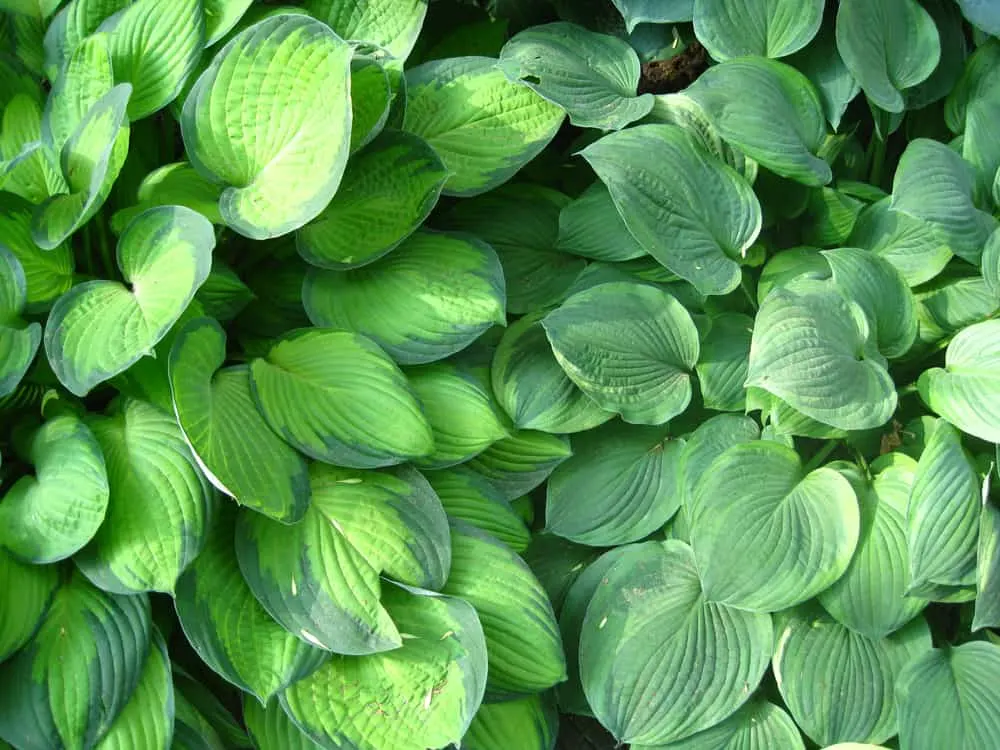
When it comes to hostas that thrive in the shade, there are so many cultivars with so much variety that it’s almost impossible to pick the right one.
These 29 are guaranteed to grow successfully in shady spots, and provide enough excitement to create an entire garden dedicated to these beautiful plants.
1. Blue Mouse Ears
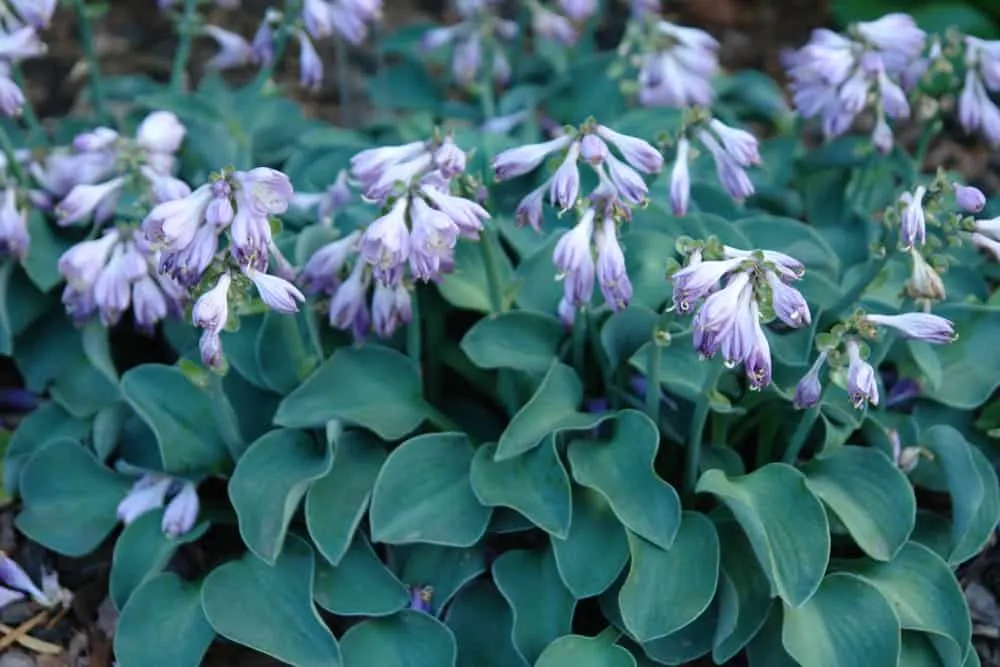
Cute and compact, Blue Mouse Ears is one of the most popular hostas, only growing to about six inches in height.
The leaves are a blue or gray-green color and form a symmetrical clump of almost succulent-like foliage. Short, bell-shaped flowers stand tall over the foliage in summer, dotting shade gardens with a touch of lavender.
Their compact size also makes them ideal for growing in containers or filling in spaces in rock gardens. Their low-profile nature and symmetry also make them a suitable ground cover for shady spots.
2. Paradigm
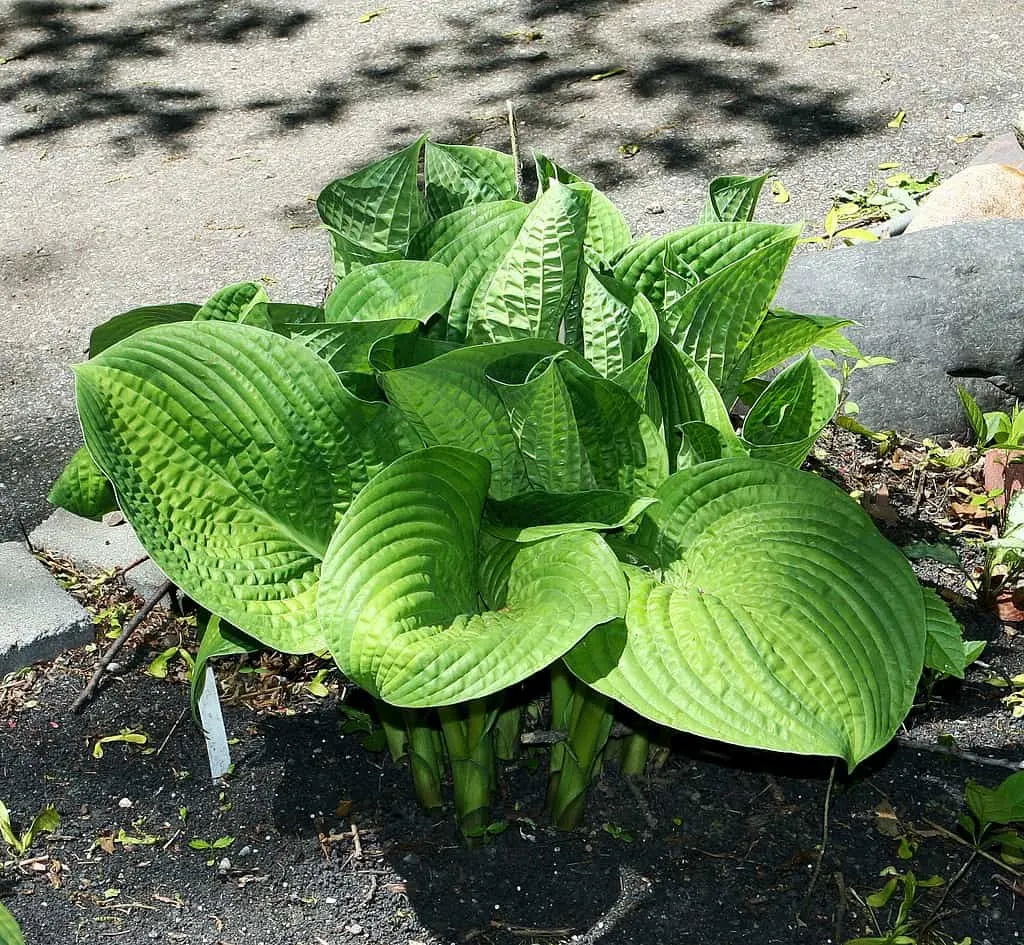
Slightly larger than Blue Mouse Ears and sporting interesting texture, we have Hosta ‘Paradigm’.
This cultivar has large cup-shaped leaves with golden green centers, edged with a darker emerald that almost appears painted on by hand. Besides their stunning color, Paradigm also features a ruffled texture and stunning white flowers that attract hummingbirds in summer.
This cultivar has one feature that makes it stand out – pest resistance. Paradigm is slug resistant, removing an issue many gardeners face when it comes to hostas.
3. Gold Standard
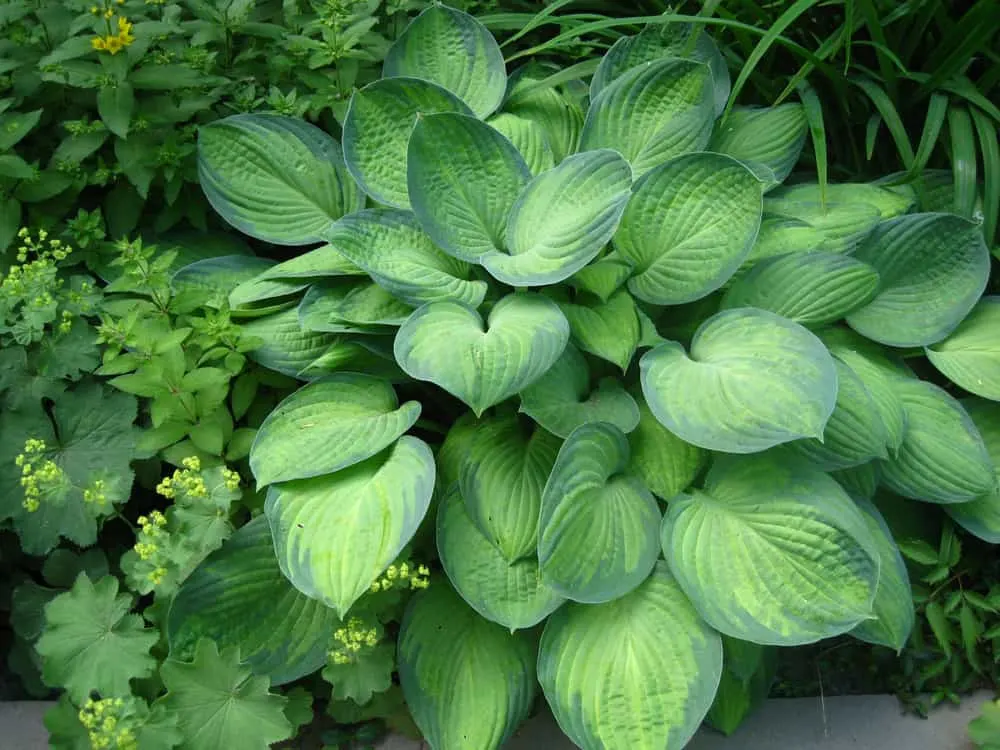
Gold Standard is around two inches taller than Paradigm and quite similar in color. Whereas Paradigm features the golden-green centers, Gold Standard displays bright chartreuse leaves with much smaller and irregular deep green edging.
This plant is the parent of many popular cultivars, winning the prestigious Award of Garden Merit from the Royal Horticultural Society. In summer, the plant produces delicate purple-pink flowers, with leaves that fade to white as the flowers fall near the end of the season.
4. Minuteman
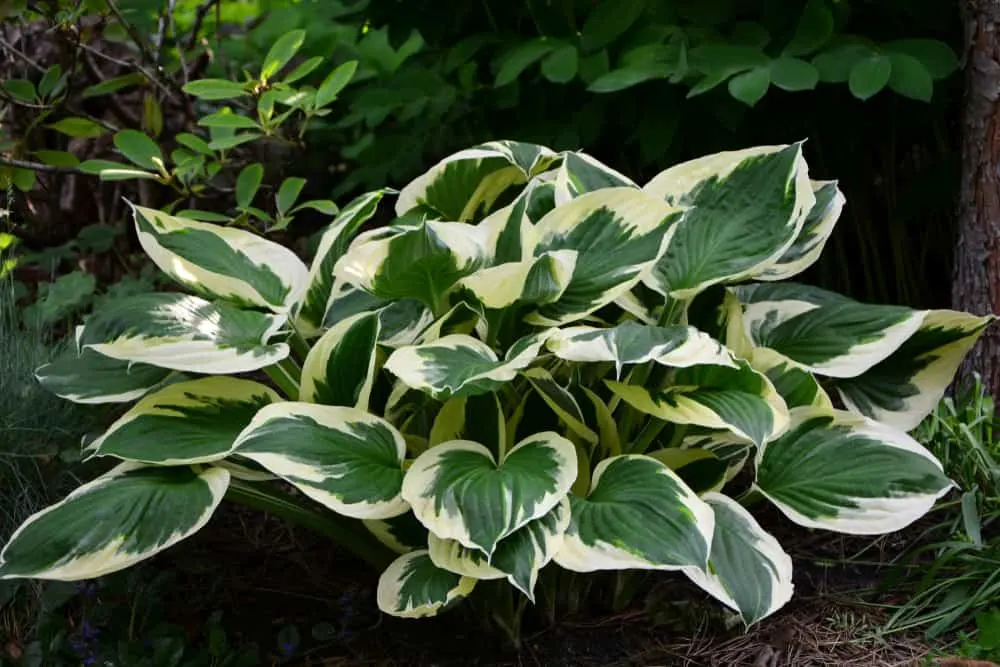
For a foliage plant guaranteed to turn heads, you can’t go wrong with Hosta ‘Minuteman’.
This cultivar is most well-known for its white margins that blend in brushstrokes to the deep green centers. Like Gold Standard, Minuteman has also received the Award of Garden Merit and is one of the most popular hostas in nurseries.
The cupped leaves have a slight ripple in them, creating an interesting texture to add to the captivating color patterns. To match the large size of the leaves, tall flower spikes emerge in spring and carry massive lavender flowers.
5. Empress Wu
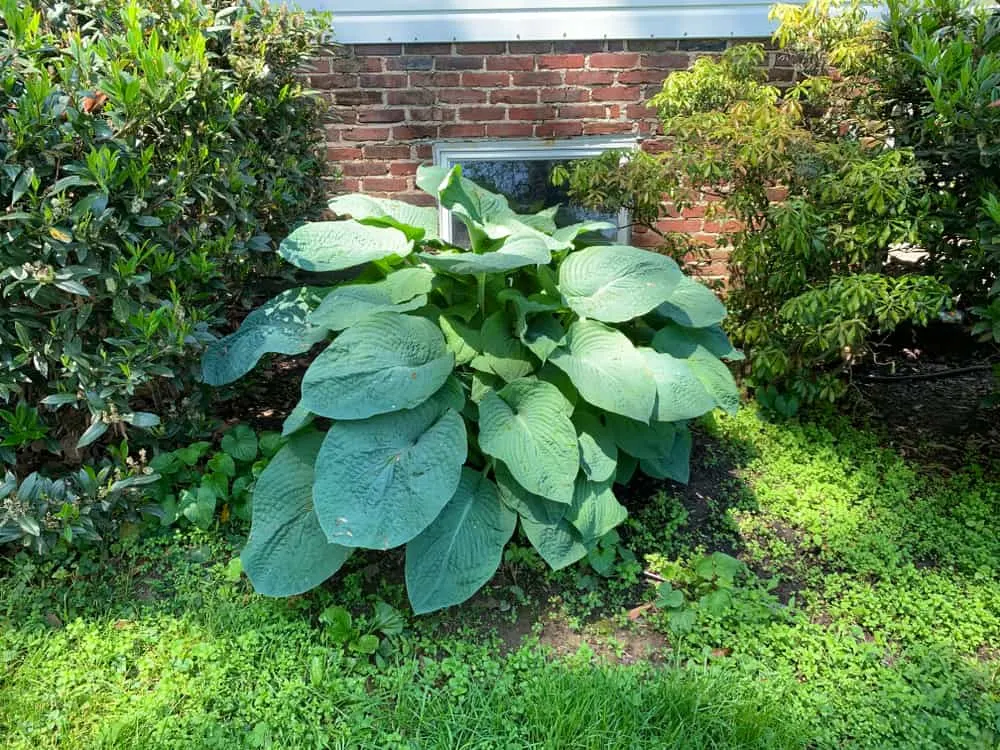
Foliage fans will love Empress Wu, the largest hosta cultivar on the market.
Reaching an unbelievable four feet in height, one leaf is almost double the size of the entire Blue Mouse Ears plant. The giant leaves have a blue tint to them in the early stages of growth thanks to a waxy coating, fading away in summer to a matte deep green that will blend excellently with the rest of your foliage garden.
Lavender flowers emerge on five-foot tall stalks, adding to the impressive spectacle that is Empress Wu.
6. Blue Angel
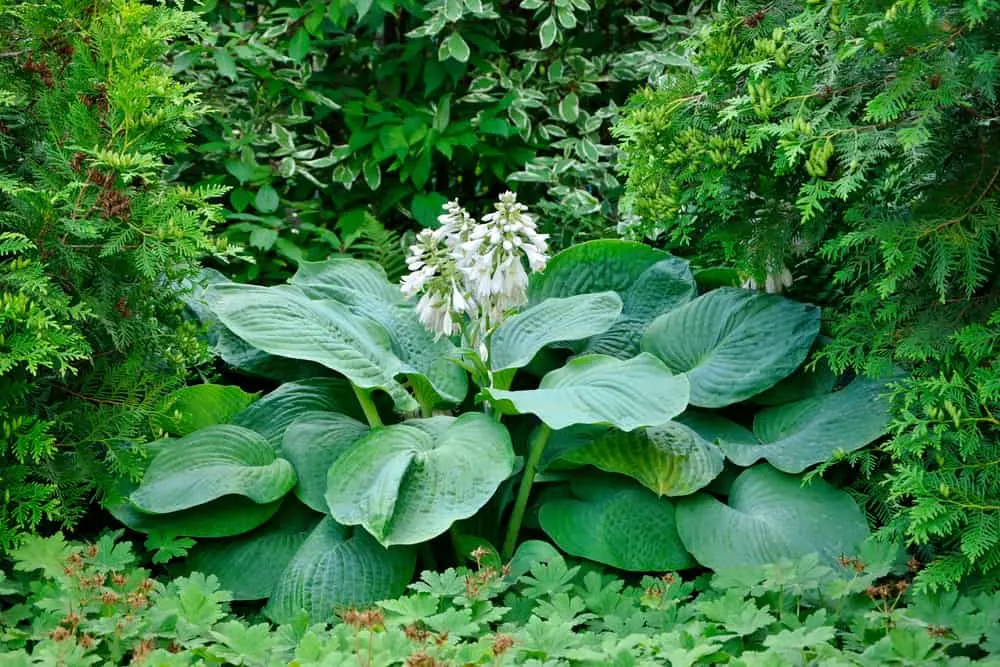
Another hosta cultivar with a blue tinge is the incredibly popular Blue Angel.
This is another large hosta variety, featuring long, heart-shaped blue leaves to a height of three feet. The leaves have a ribbed texture and sport the glaucous coating that keeps the leaves a moody blue in cool weather. Whiteish lavender blooms peek through the cascading foliage in summer.
Blue Angel is one of the most commonly purchased blue hostas due to its ability to tolerate higher heat conditions that can remove the waxy coating and turn the leaves green.
7. Touch of Class
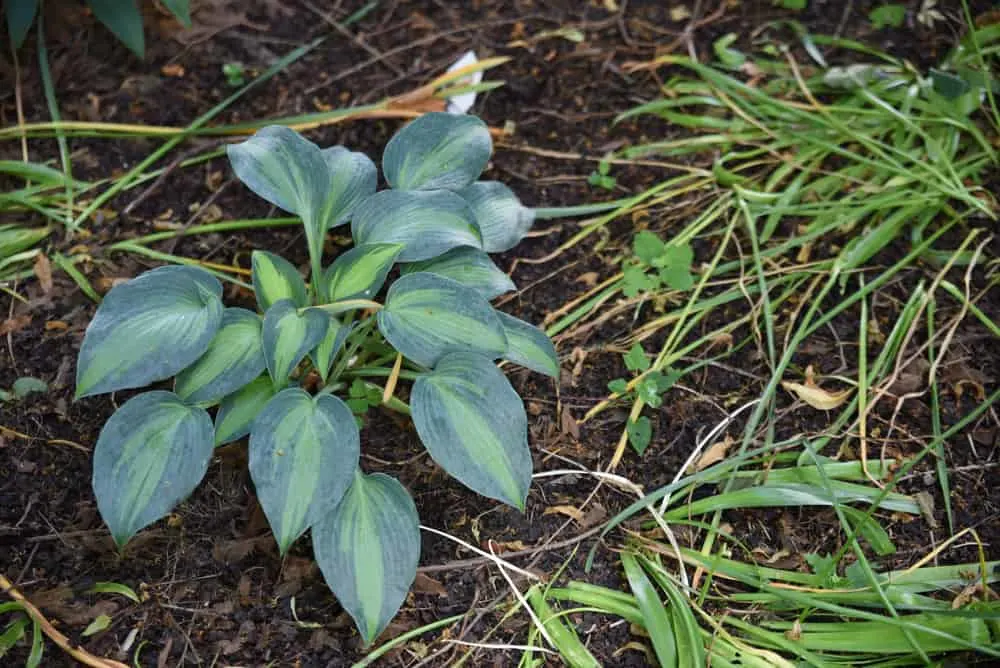
For a more compact blue hosta with a bit of flair, opt for Touch of Class.
This cultivar has the stunning shiny blue leaves that these plants are famous for, coupled with a bright green center. This center is far smaller than some of the other patterned varieties, almost in the shape of a racing stripe.
This interesting pattern is quite unique, and ensures you get the best of both worlds when planting this cultivar.
8. Patriot
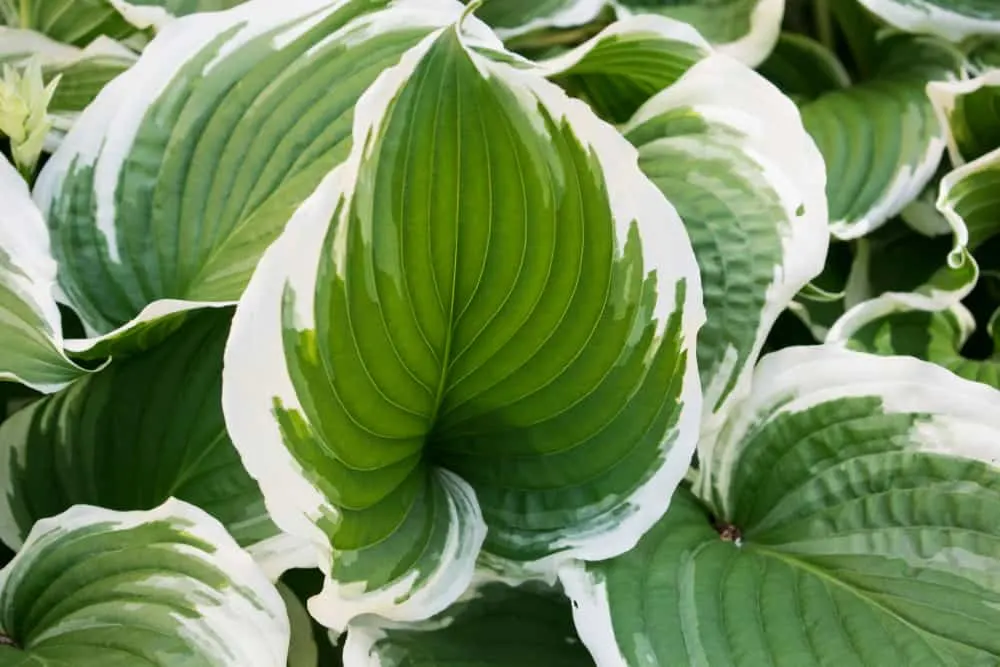
Like Minuteman, Patriot also features stark green leaves with white borders. However, this cultivar is more compact, growing to about one foot tall. This makes them ideal for filling in gaps in flowers beds to act as a ground cover, or for planting in containers.
Blueish purple flowers appear above the flowers, but don’t detract from the standout leaf variegation. This cultivar is also a relatively quick grower compared to some of the others, ideal for impatient gardeners or those needing to fill a space quickly.
9. Sum and Substance
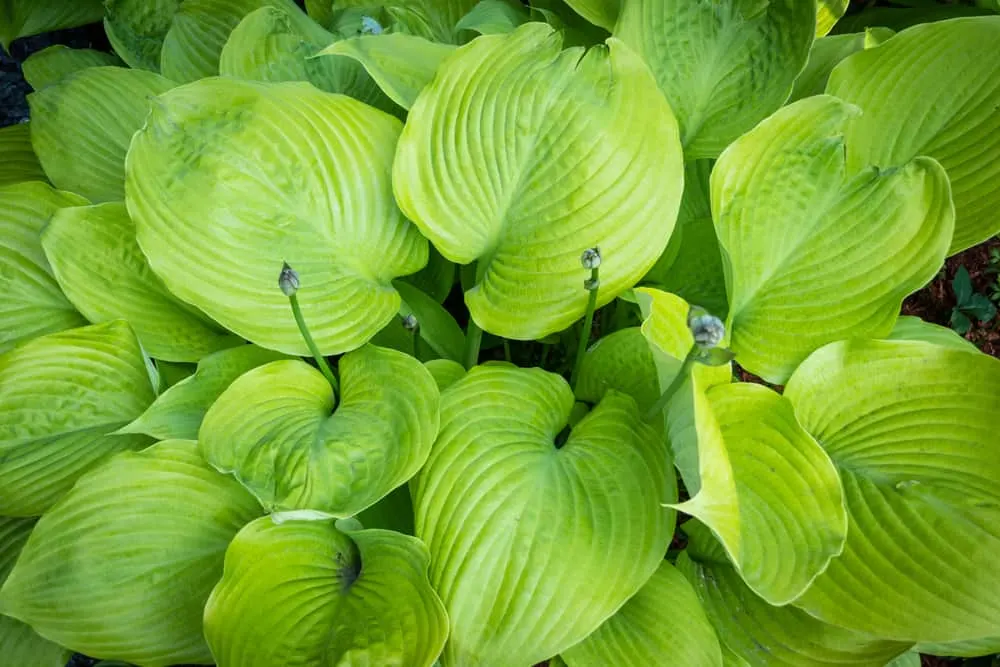
Blue hostas are not the only large varieties. Lovers of bright yellow and green tones will instantly become obsessed with Sum and Substance, a cultivar with a name that tells all.
Each leaf has deep veins that create an interesting texture across the monochrome tone. The size and shape is similar to Blue Angel, the hostas bright and colorful cousin. This cultivar is also one of the most resistant to slugs and snails, pests you certainly want to avoid in your hosta garden (and your garden as a whole).
It does require higher light than some other cultivars to maintain its bright color and is best for partial shade gardens rather than full shade.
10. Sagae
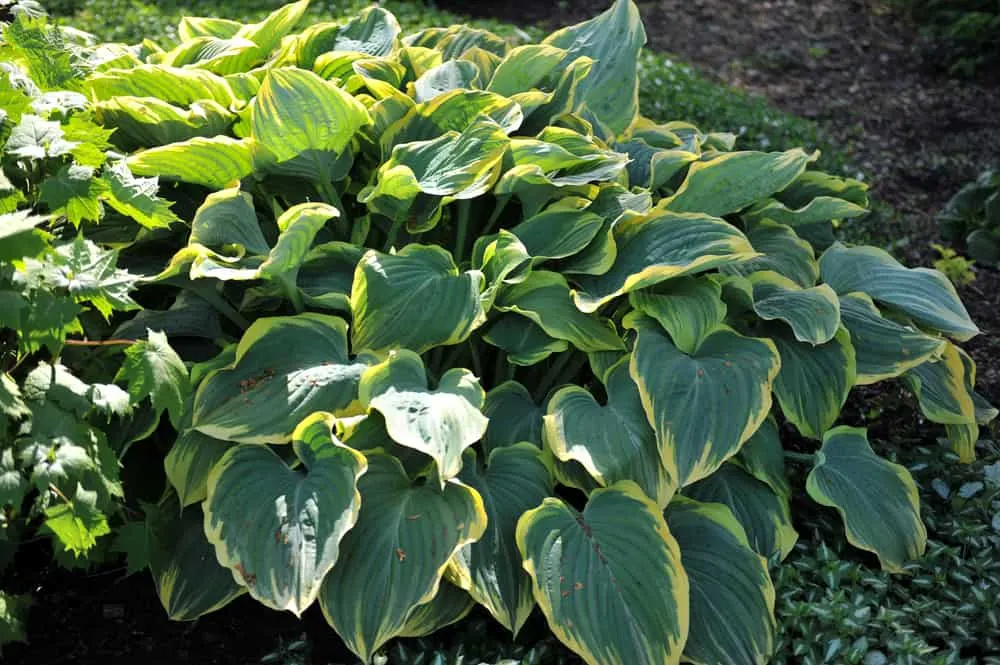
Although the white-bordered hostas are some of the most popular, there are many other color variations of the same pattern.
Sagae, another popular cultivar, displays this pattern perfectly. The large leaves have frosted blue-green centers, surrounded by a golden yellow margin that blends effortlessly into the center. These yellow margins change color to white towards the end of the season, giving you the best of both worlds.
Although not as tall as some of the other giant varieties, Sagae has a large spread, growing around five feet wide at maturity.
11. Curly Fries
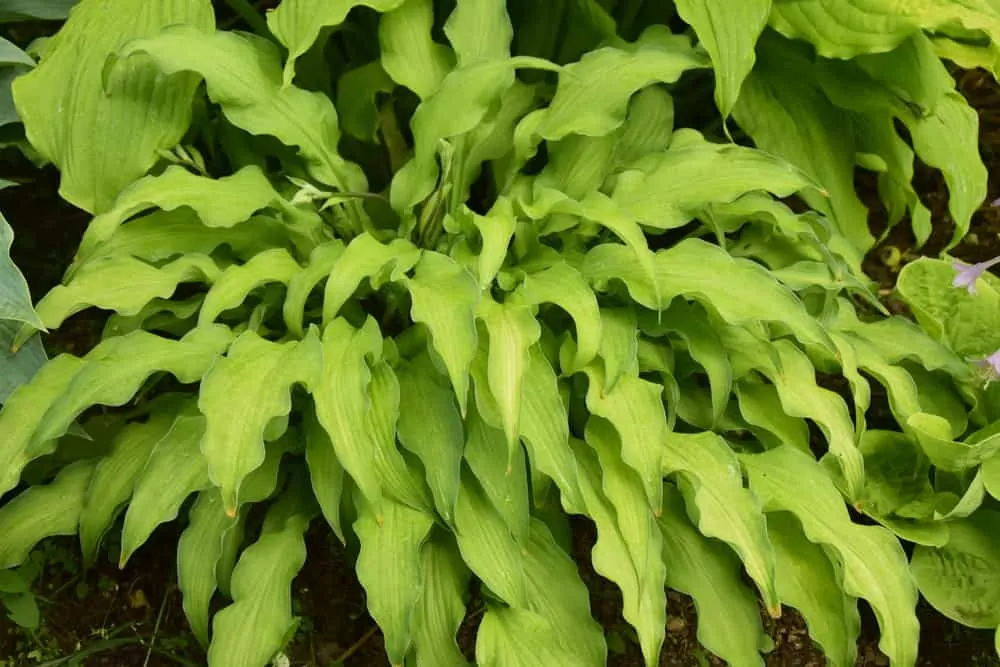
If you came across this plant in the nursery without looking at the label, you would have no idea it’s actually a hosta. Curly Fries is completely different from many of the popular cultivars in leaf shape.
Here, the name says it all – the foliage really does look like curly fries. Each long chartreuse leaf is slightly rippled, creating a grass or fern-like appearance, especially when moving with the wind.
This fascinating cultivar is incredibly compact, even smaller than the tiny Blue Mouse Ears in height. To maintain the bright color, keep this hosta in a partial or dappled shade position.
12. Abiqua Drinking Gourd
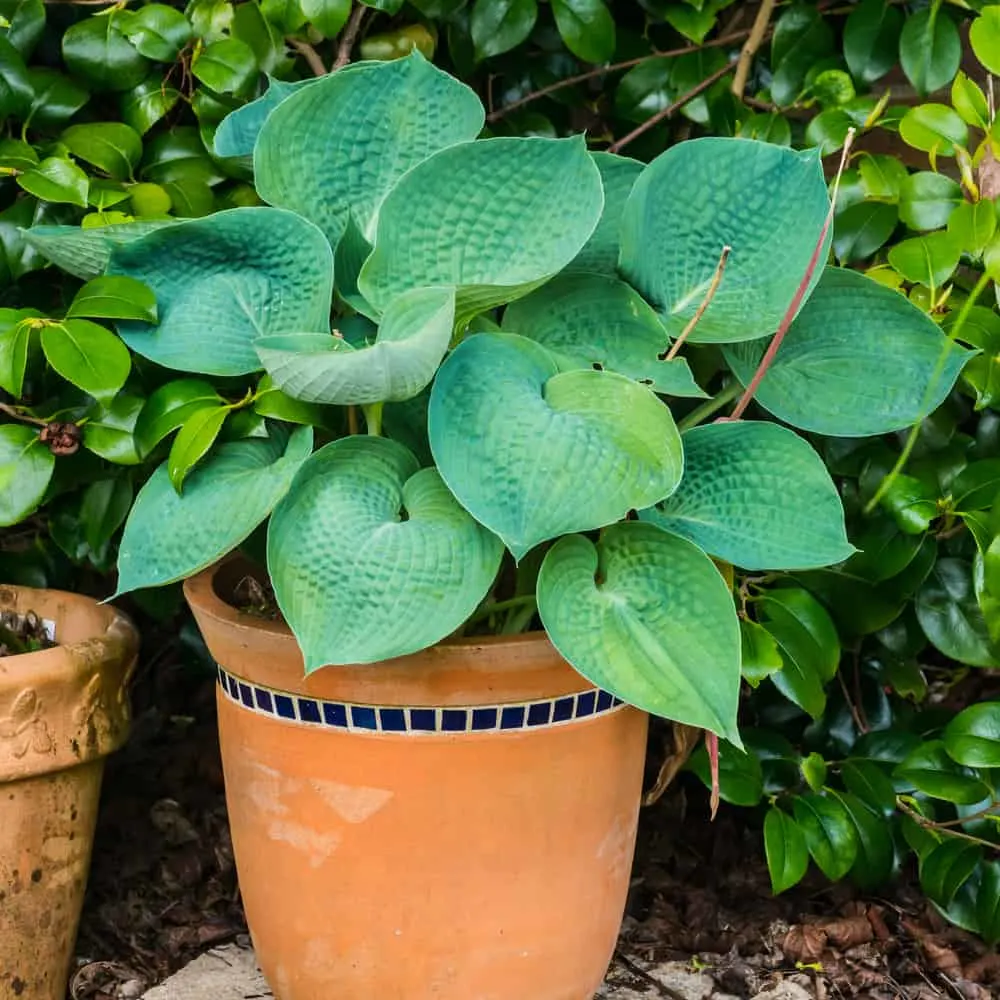
You’d be lucky to find one of these cultivars at your local nursery – they are so popular they tend to sell out almost immediately.
This blue hosta is also one of the bluest, with interesting cup-shaped leaves that topple over one another in a dense clump. These cups are a few inches deep and hold plenty of water after the rain, slowly dripping into the soil to provide the moist conditions these plants love.
It is also quite resistant to slugs, despite the moisture that holds onto the leaves.
13. Autumn Frost
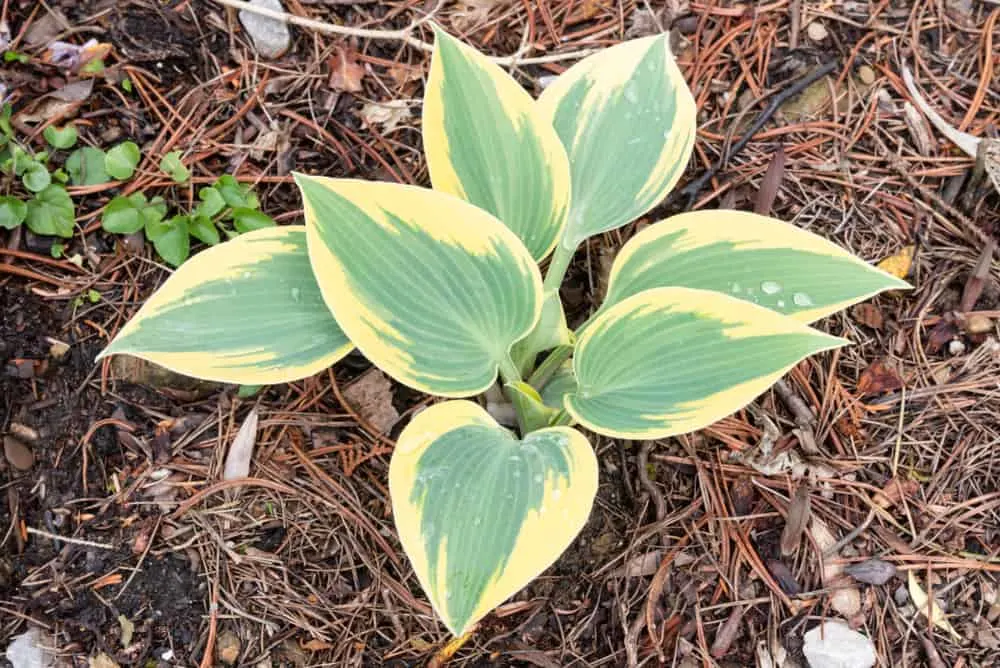
This sport of the popular First Frost (mentioned later) is for the color-obsessed gardeners.
The margins of Autumn Frost are an intense yellow, especially when given a little sunlight throughout the day. The centers are a dusty blue-green, contrasting perfectly with the leaf edging. The edges also fade to white, like many other cultivars, keeping your garden interesting throughout fall.
Before they change color, the plant produces delicate lavender flowers in the last moments of summer – the perfect way to send off the season.
14. Whirlwind
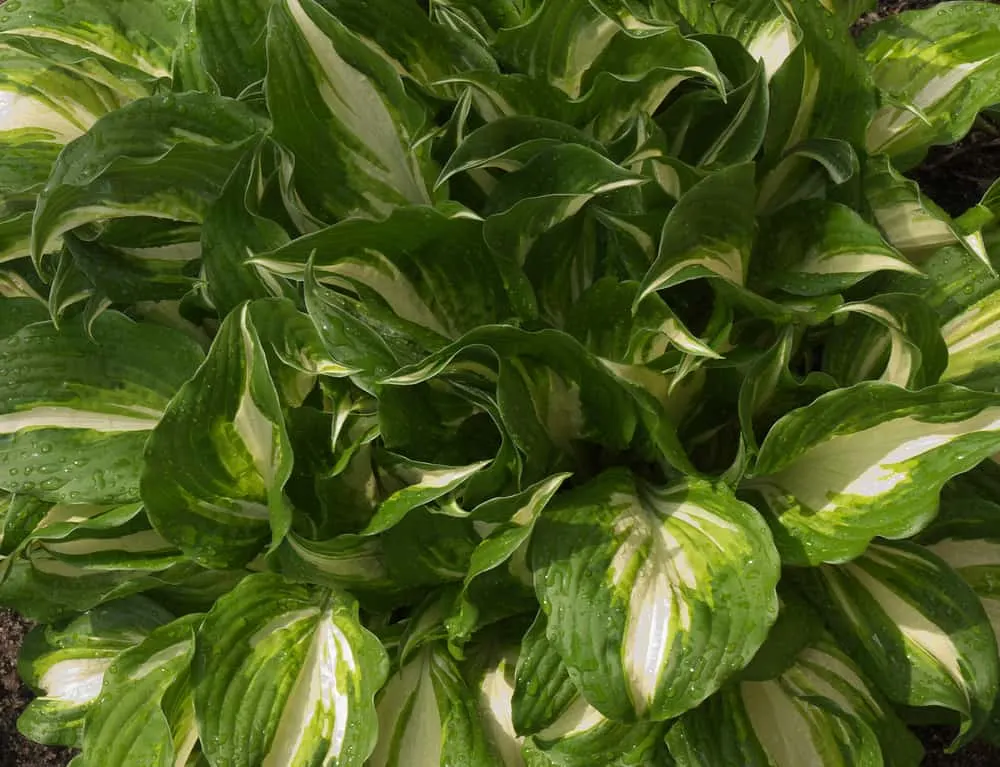
This showstopping cultivar is full of surprises.
Whirlwind is smaller in size, growing around one foot tall and three feet wide. The leaves form dense clumps for a unified mirage of green. While the edges of the leaves remain this deep green, the centers change color with the seasons. Starting a dusty white in spring, the middle of the leaves change to a lighter green in summer as the plant flowers and darken to a deep green later to match the plant’s edging.
This plant is also a quick grower, spreading to fill up empty spaces with ease.
15. Krossa Regal
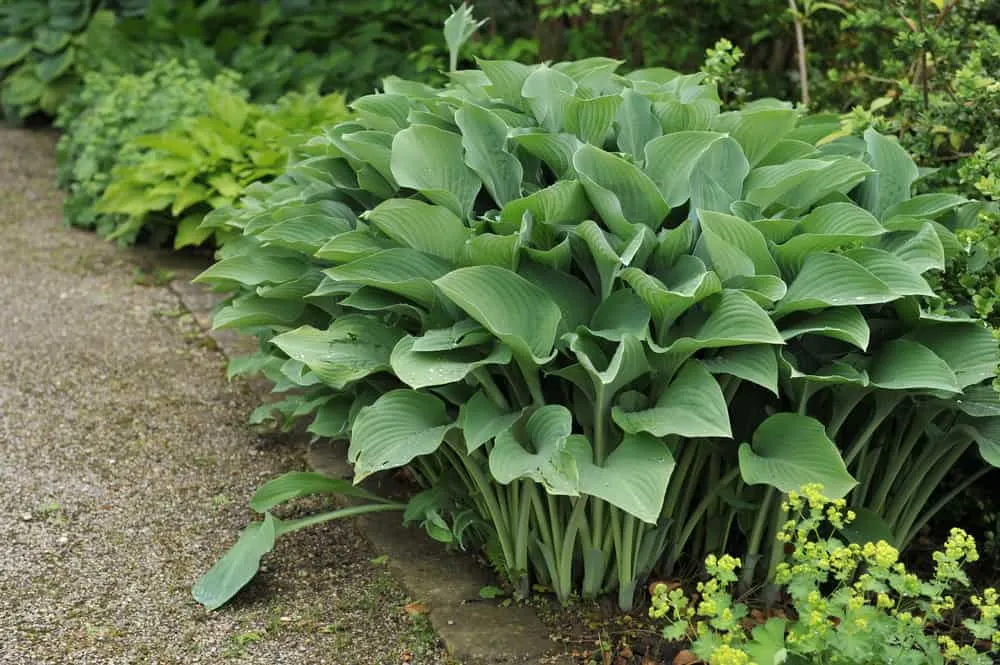
If you’re not a fan of changing colors and prefer a monochrome look, but still want a hosta with a bit of variety, try Krossa Regal.
The green leaves, dusted with a spot of blue, stand far more upright than any other cultivars. The entire plant forms a tight vase shape that lifts the leaves off the ground.
Combined with the massive size of the plant – growing around six feet wide – Krossa Regal is sure to turn heads.
16. Diamond Lake
Gardening trendsetters looking to get ahead of the curve need a Diamond Lake Hosta in their garden.
This stunning cultivar, featuring blue-green pointed leaves with rippled edges, is the Proven Winners Hosta of the Year for 2022. The foliage is heavily textured and corrugated, adding further interest to your shade garden.
Beyond all these benefits, this cultivar is also considered premium, with high resistance to pests and the ability to adapt to a wide range of growing conditions.
17. June
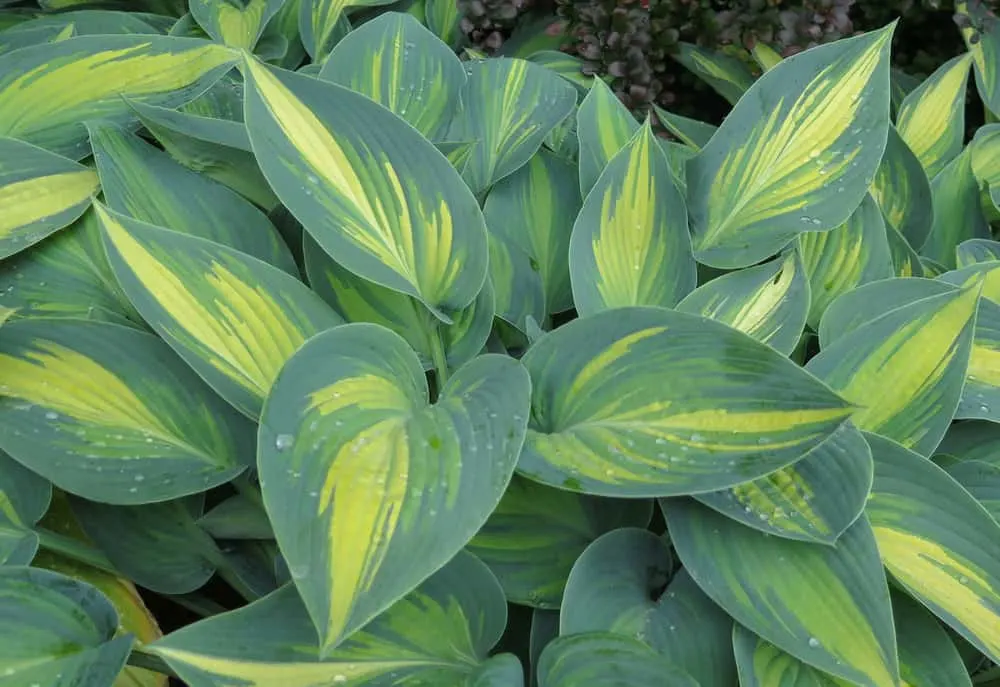
June is another compact hosta with plenty of character.
This cultivar has a captivating variegation pattern. The leaves are edged in a deep green-blue, with stripes of bright yellow and light green streaking across the center. As the patterns are inconsistent, each leaf looks slightly different.
As another incredibly popular cultivar, this is a must-have for collectors or those with small gardens due to its short stature.
18. Halcyon
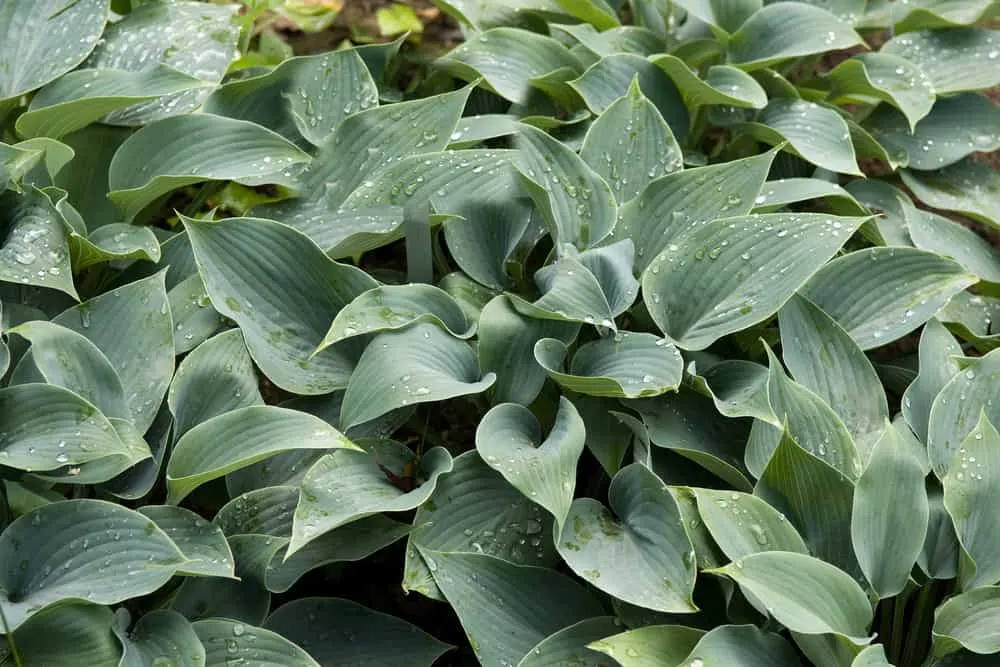
June is a sport of Halcyon, a cultivar some have labeled the best blue hosta. The blue-tinted leaves start out long and upright, morphing into a heart shape as the plant matures. This plant is one of the best options for deep shade, as it needs protection from the sun to retain its enchanting blue coating.
In summer, this low-growing cultivar produces tall violet flowers that attract birds and bees to your garden. Plant at the border of your flower beds to frame the space with an attractive foliage plant.
19. Big Daddy
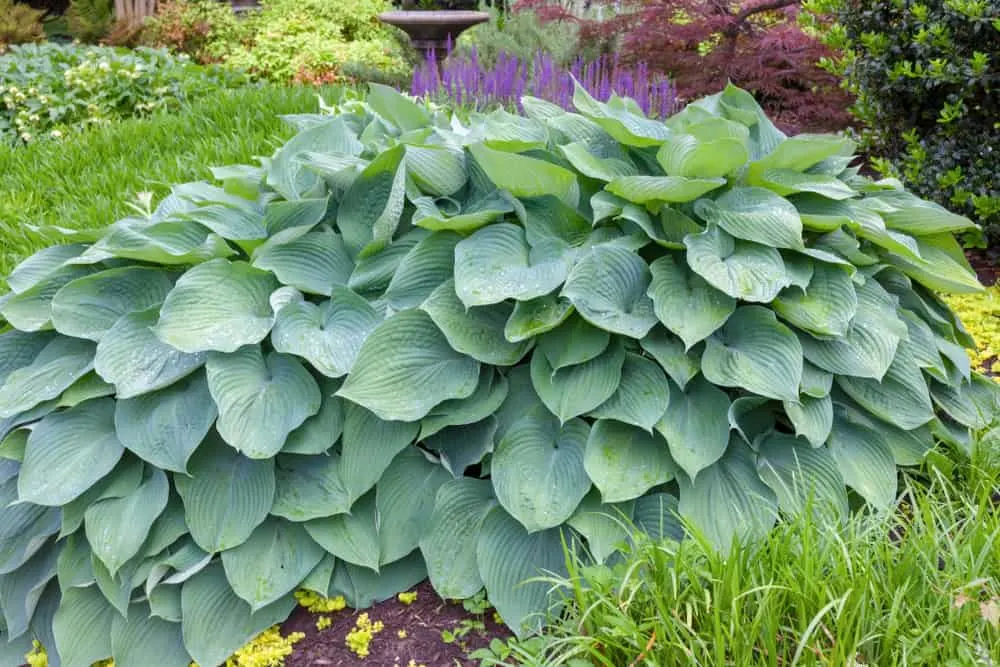
Big Daddy is one of the most popular giant hostas, featuring massive rounded leaves that spread to cover large swathes of your garden beds. The blue waxy coating is quite pronounced, giving the leaves a blue-grey sheen.
This is another cultivar ideal for deep shade to preserve the chalky blue color. Small white flowers peek through the blue leaves in summer, topping the entire plant with delicate blossoms that contrast with the plant’s overwhelming size.
20. Wolverine
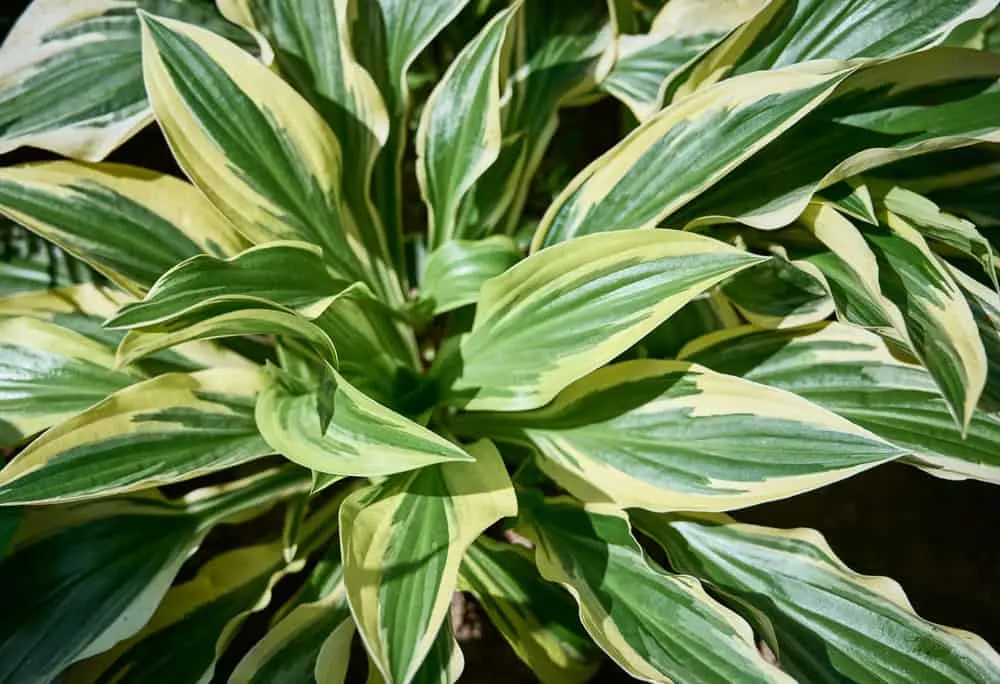
For a mix in shape between Curly Fries and the round-leaved hostas, try Wolverine.
The leaves are long and pointed, cascading outwards from the center of the plant. The classic blue-green tone features in the middle of the leaves, surrounded by a golden yellow that becomes more pronounced with sun exposure.
A sport of Dorset Blue, this cultivar has also received an RHS Award of Garden Merit, certifying its place as a must-have hosta.
21. Deja Blu
Returning to hostas with interesting leaf patterns, few can match Deja Blu, a unique cultivar. The greenish-blue leaf centers are surrounded by jagged edges of white, fading into yellow, and finally touched with a dash of light green.
This cultivar is a sport of Blue Boy, with soft, shiny foliage. A bit of morning sun will make the unique colors of this cultivar even more pronounced, catching your eye every time you step outside.
22. Pandora’s Box
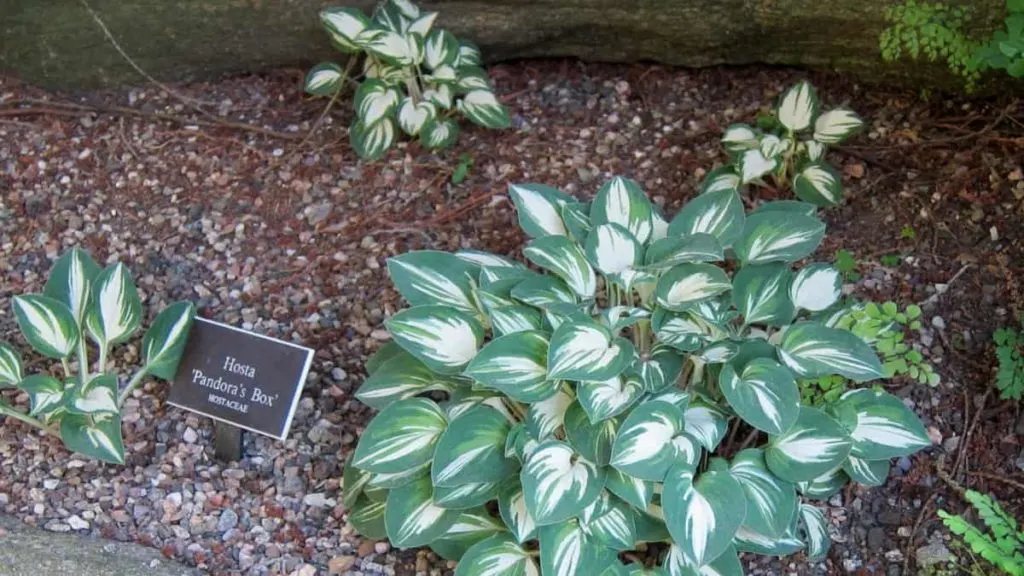
You may struggle to find this cultivar in your local garden center, so snatch it up as soon as you see one for a compact hosta with incredible color.
Pandora’s Box leaves are a bright white, surrounded by streaks of deep green that move out to the margins. The leaves are far smaller in size than other cultivars (around two inches long) but are plentiful, covering the entire area in masses of white and green.
Small lavender flowers grow tall above the dense foliage, forming a delicate feature with plenty of interest.
23. First Frost
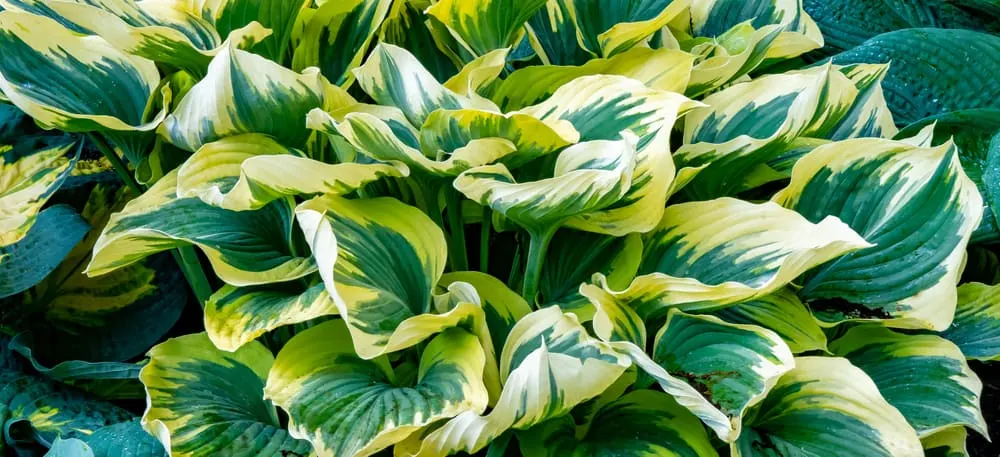
Another sport of Halcyon, this cultivar is quite similar in pattern to June, but completely different in terms of color.
In spring, the cascading leaves of First Frost are a stark chalky blue, surrounded by a captivating bright yellow margin. Rather than creating a strong line between the two colors, this margin blends softly into the blue center at various points, creating an interesting color transition. The yellow fades to a stark white in summer, similar to the other white-edged cultivars.
24. Fire Island
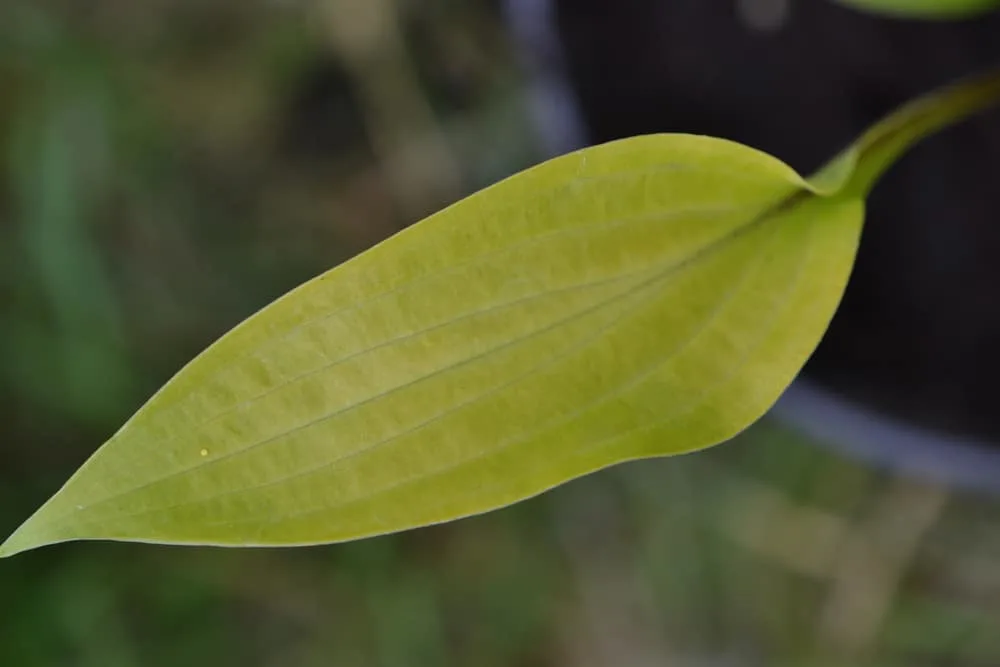
The Fire Island cultivar is an interesting shade of warm yellow, hence its name. Relatively compact, this plant prefers a bit of direct sun for a few hours in the day to maintain its intensely bright color.
Planting amongst other foliage plants in partial shade gardens, the leaves of Fire Island instantly stand out, unlike any other plant in your garden. To contrast the bright yellow, red petioles form the base of the plant, with the color creeping slightly into the base of the leaves.
To top off the color spectacle, lavender flowers appear from the middle of summer.
25. Mighty Mouse
This cultivar, a sport of Blue Mouse Ears, features the same cute rounded leaves that give the plant its name.
But, Mighty Mouse is very different from the standard blue of its parent plant. This cultivar remains compact, with small leaves, but features stunning variegation with creamy yellow leaf borders.
This plant is the perfect colorful ground cover for beds, and will look stunning when paired with other foliage plants in a large patio container.
26. Vulcan
Another small to medium hosta variety, Vulcan is beloved for the creamy white centers that fade into a classic green. The transition between the two colors is softened by areas of light green and creamy yellow that give the leaves a pattern unlike any other cultivar.
Vulcan is also an incredibly quick grower, a great alternative to some of the slow-growing white-centered cultivars.
27. Coast To Coast
This plant received the award for National Hosta of the Year in 2020, awarded by Proven Winners.
Similar in color to Fire Island, Coast to Coast is an impressively large cultivar with luminous chartreuse leaves. As the plant grows, the wavy texture intensifies and the leaves turn more golden, dotted with star-shaped lavender flowers in the summer.
These large plants may grow well in containers due to their upright growth habit, but need plenty of space to spread outwards.
28. Cool As A Cucumber
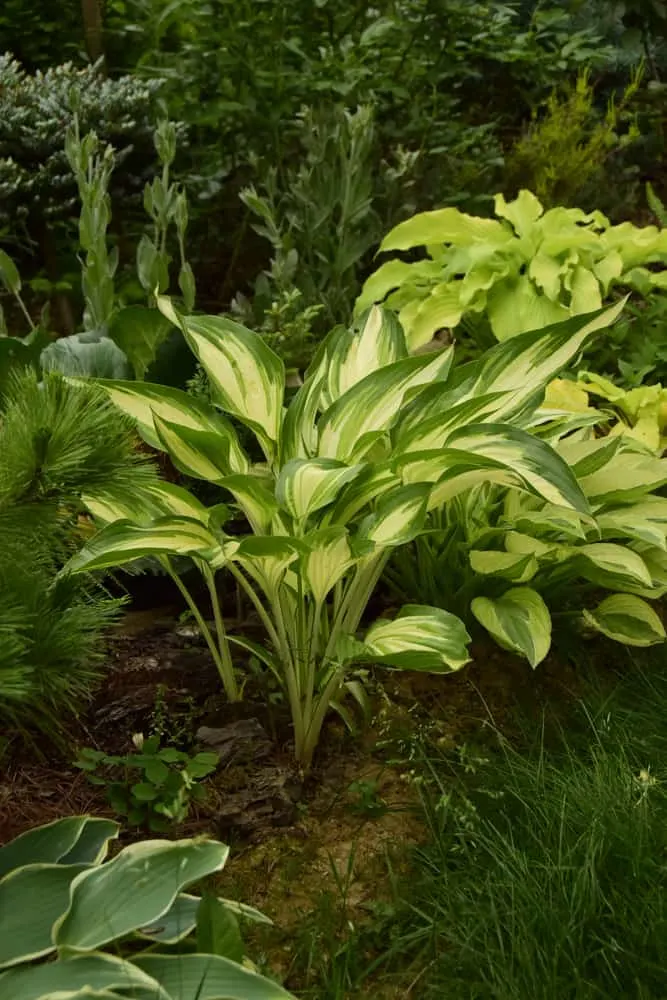
This is one cultivar that looks hand-painted, its colors almost difficult to believe.
Cool as a Cucumber Hostas have long, pointed leaf shapes that peel outwards to fall over one another in a light, delicate cluster. Each leaf is streaked with light green stripes, bordered by dark green margins with the classic hosta bright white taking center stage.
Whitish lavender flowers are the cherry on top, forming an artistic statement in any shade garden.
29. Komodo Dragon
And finally, we have Komodo Dragon. This massive cultivar has a huge spread – up to seven feet – but sticks lower to the ground than some of the other giant varieties at three feet.
Where Komodo Dragon does stand out is in the leaf sizes that can reach a whopping 15 inches long. These massive leaves are slightly rippled at the edges, creating a unique look when clumped together.
Give this plant plenty of space to spread and it will fill up a bed in no time.
You cannot go wrong planting hostas. There is immense variety in color, texture, size and shape, providing an ideal option for every gardener.
If you find more than one variety catching your eye (I don’t blame you), you can plant them all together as each cultivar enjoys incredibly similar growing conditions. Pair a few shady hostas with a couple of leafy ferns for a foliage garden guaranteed to dazzle.
